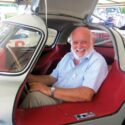1921: the year America first conquered Le Mans
A glorious home win for Ernest Ballot’s team had been predicted at the 1921 French Grand Prix but the Duesenbergs foiled it on French soil
One hundred years ago come July 25 – America (with help from German and Irish immigrant genes) won the 1921 Grand Prix of the Automobile Club de France. That first post-WW1 international Grand Prix race comprised 30 laps of the 10.75-mile Sarthe circuit at Le Mans. A glorious home win for new French manufacturer Ernest Ballot’s team of 3-litre straight-8 twin-overhead camshaft cars had been predicted, but it had been foiled.
The German-born brothers Fred and Augie Duesenberg had entered their own team of similarly specified Indianapolis-bred cars, and with their fearless and relentlessly rapid lead driver Jimmy Murphy – son of Irish immigrants – they defeated the French on home soil…
While none of the Duesenberg children had much formal education, both Fred (born Friedrich) and Augie (August) showed mechanical aptitude. Fred began racing bicycles, built his own, then in 1900 attached a petrol engine to one. Through creating Rambler, then Mason and Maytag-Mason cars the brothers developed 4-cylinder and then straight-8 designs which quickly earned respect. In 1913 they founded the Duesenberg Motors Company Inc and in 1914 Eddie Rickenbacker placed 10th in the Indy ‘500’ in a Duesenberg.
During World War 1 the brothers worked on Government contracts. Fred was the father figure and engineer, four-years younger Augie, a natural practical craftsman mechanic.
Postwar, in France, on Christmas Eve 1918, former Peugeot engineer Ernest Henry was commissioned by marine-engine manufacturer Ernest Ballot to create a team of racing cars to promote an image of technical excellence. They were to run at Indy in the 1919 revival ‘500’ – so had to be ready for shipping in just 120 days.
Henry drew Peugeot-like chassis and in effect coupled two 4-cylinder engines into a straight-8. These new Ballots shone at Indy, fastest in practice but were beaten into second.
Back at Indy in 1920, Gaston Chevrolet won in his Peugeot-inspired Monroe – but Ralph de Palma had led until the last 35 miles for Ballot. René Thomas’ Ballot was second, and the latest Duesenbergs 3-4-6.
Into 1921 American racing’s 3-litre capacity ceiling was adopted by the ACF for their resumed Grand Prix. At Indy that year Tommy Milton’s Duesenberg-inspired, Miller-engined straight-8 Frontenac won. Italian-born American Ralph de Palma’s Ballot had led for 200 miles – but failed yet again.
By this time the Duesenbergs were desperate for major success. Ballot was loudly promoting his products’ moral ascendancy. For the revived GP, Ballot confirmed four entries to be driven by Louis Wagner, Jean Chassagne, Jules Goux and de Palma. With backing from the American Automobile Association, the City of Indianapolis and Albert Champion – the Frenchman whose US spark plug business had made his fortune – Duesenberg also entered four Indy-derived cars for Americans Jimmy Murphy and Joe Boyer, plus Frenchmen Albert Guyot and Louis Inghibert.
“Duesenberg‘s arrival was last minute but the cars were well prepared”
Duesenberg’s arrival was last minute but the cars were well prepared, with Augie as chief engineer, and American road racer George Robertson as team manager. The Duesenbergs were unique in using hydraulic brakes instead of rod and cable. Early brake balance problems saw Murphy suffer a lock-up avoiding a bolting horse while returning to Le Mans after practice. The car overturned in a ditch, breaking Inghibert’s ribs and injuring Murphy’s less severely. Murphy was released from hospital for the race, but Inghibert’s car was rented to French driver André Dubonnet.
Ernie Olson, Murphy’s riding mechanic, had noticed that Ballot used far smaller brake drums at front than rear. Duesenberg’s were same-sized all round. Olson suggested to Augie they hack away 2in of the metallic lining from their front brake shoes to match. Boyer tested the modified car with Olson alongside, who recalled: “We hurtled down the straight, he hit the brakes and the car just squatted. It tried to bury itself in the road without a bobble. We really had it over the French after that…”.
From the staggered start de Palma appeared to cruise, while the Duesenbergs blazed round 1-2. Murphy led from team-mate Guyot. De Palma, urged on by riding mechanic nephew Pete de Paolo, inherited second place despite a stone-punctured fuel tank. But on lap 29 another flying stone punctured leader Murphy’s radiator. A tyre also burst. The Duesenberg slewed into the pits. Olson changed the wheel. Murphy (illegally) kept the engine running while hot water was poured into the leaking radiator. Back in action it soon boiled dry. With eight miles to go another tyre deflated. Only the straight-8’s large oil-cooling area kept it together for those last miles. Waving in triumph, Murphy and Olson bumped across the finish line to win the Grand Prix for America. They had averaged over 78mph for the 322 miles, Murphy left the Sarthe lap record at 84mph while his last lap had averaged only 59. Still the Duesenberg finished more than a quarter-hour ahead of de Palma.
As after Mercedes’ crushing defeat of Peugeot (and La France) in the 1914 Grand Prix, the winning nation’s anthem was not played after the finish. Ernest Ballot was incensed, raving, “Let’s do it again! We’ll see who keeps going to the finish!”.
But the names of Jimmy Murphy and the slender – though two-seat – Duesenberg had already been inscribed in the Grand Prix record book. Now here’s a centenary to savour.
Doug Nye is the UK’s leading motor racing historian and has been writing authoritatively about the sport since the 1960s

